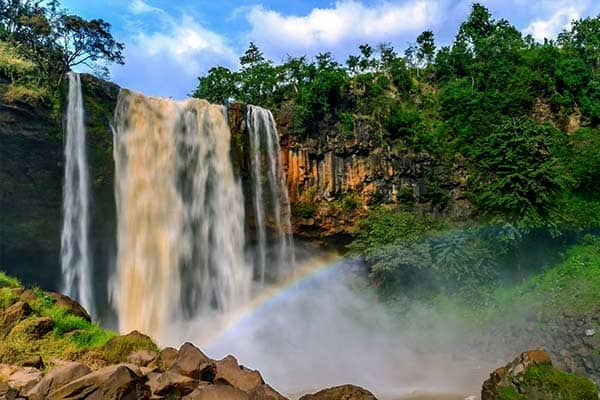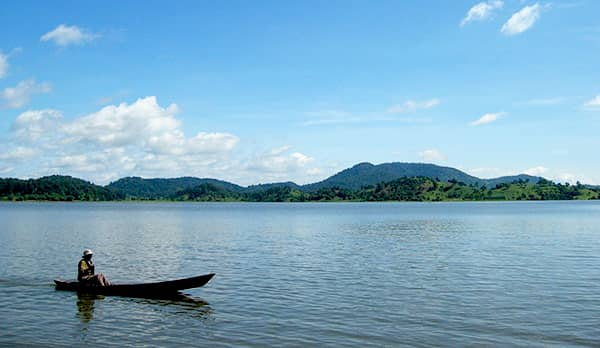THE HIGHLAND OF TAY NGUYEN - CENTRAL VIETNAM
DISCOVER THE DAILY LIFE OF MINORITY ETHNICS IN VIETNAM
Vietnam's highland region is a land full of mountains, primeval forests and small ethnic minority communities located in central Vietnam.
General presentation
The Central Highlands include five provinces: Dak Lak, Dak Nong, Gia Lai, Kon Tum and Lam Dong. For a long time, the region was left largely unpopulated. The inhabitants are made up of many ethnic minority communities, the largest being the Jarai, Rade, Bahnar, Koho and Mnong. Most of the time, the mountain people lived in peace and it was only when the French discovered the agricultural value of this land that things began to change. The progressive exploitation of the region by the Vietnamese has provoked protests from the inhabitants. This situation, combined with long-standing tensions between ethnic minorities and the government, led to a ban on tourist visits to the region in the early 2000s. Although the restrictions have been lifted, some areas still require a permit from the police or tourist guides.
That being said, the highlands of Central Vietnam offer a fantastic opportunity to experience a Vietnam that has not yet been transformed by tourism. Apart from the culture of these highland communities, the region is also an exceptional natural beauty with a number of fantastic national parks and amazing animal species, including a small number of elephants and tigers.
What to see in the Tay Nguyen highlands?
Buon Ma Thuot
The capital, Buon Ma Thuot, was the scene of the decisive 1975 battle that led to the retirement of the South Vietnamese army. Since the devastation of the war, it has been rebuilt, modernized and maintained as in many other cities in Vietnam. This is largely due to high immigration from other parts of Vietnam. That being said, there are still many interesting villages belonging to ethnic minorities and beautiful natural sites to explore in the area.
The Buon Ma Thuot Ethnographic Museum is an excellent place to start discovering the interesting cultures of the Central Vietnam Highlands. The museum provides excellent illustrations and explanations of some of the cultural activities and ceremonies held in ethnic minority villages.
Lake Lak is the ideal place to discover the natural beauty of Central Vietnam and the wild countryside and traditional villages that populate its shores. The vast expanse of water, the largest in the region, lies within the rolling wooded mountains. Small wooden boats are available for walks around the lake. The modest traditional houses on stilts in the Mnong community provide an insight into their culture and way of life. It is also possible to participate in a performance of the gong dance, a sacred instrument for contacting the gods. The rituals surrounding it have even been recognized by UNESCO as a masterpiece of the oral or intangible heritage of humanity.

Cascade of Dray Nur in Buon Me Thuot
Another short trip out of Buon Ma Thuot takes you to the beautiful Dray Nur waterfall. Cascades are more impressive when the flow is very high and sunlight infiltrates the water. A little further from Dray Nur is another waterfall called Dray Sap. Although not as large or as impressive as Dray Nur, this picturesque waterfall is also a good place to have a picnic or simply to relax in the charm of nature.
A few kilometres from Buon Ma Thuot is a village of the Ede called Ako Dhong where visitors can learn more about life in a traditional village in central Vietnam. The village is rich because of its coffee production. In addition to modern houses, there are also many beautiful and traditional long houses on wooden stilts. The villagers are trying to preserve other traditions such as alcohol production and the weaving of beautiful brocades.
Yok Don National Park is easily accessible from Buon Ma Thuot. This park includes 115,000 hectares of protected forest and is full of wildlife. Accommodation is available in the park for those who want to explore nature in a few days. Tours organised with the mandatory accompaniment of guides vary in length and capacity, and some also offer a night safari to better observe the fauna. There are also four ethnic minority villages in the park, three of which can be visited with guides. You can also take a boat trip, hike the Buddha waterfall or simply relax in a hammock and admire the landscapes and sounds of nature.
Cat Tien Natural Park, wild and sublime, is located 260 km southwest of Buon Ma Thuot. Among the tropical jungles and bamboo forests are streams and swamps, some of which swell and are flooded during the rainy season. This large and vast national park is ideal for hiking or cycling and can be enjoyed either on a day trip or over several days. The area is classified by UNESCO as a biosphere reserve, more than 100 types of mammals can be observed in the park with the help of expert guides. Some of the 350 bird species or 400 butterfly species are more easily spotted. There are also a number of different animals that can be seen up close in the park's protection centres: the Endangered Primate Species Centre, which houses gibbons and langurs, and the Cat Tien Bear emergency shelter. The park offers many trekking routes, most of which must be done with the help of a guide.
Kon Tum
Similar to Buon Ma Thuot, Kon Tum was devastated by the war between America and Veitnam. Today, however, the atmosphere is peaceful and inviting, and the city is a good starting point to explore the many ethnic minority villages that surround it. The city itself has interesting aspects such as the architecture of the mountain church, which combines aspects of the French colonial style entirely in wood.
Outside the sleeping city, a number of different ethnic minorities live in traditional villages, most of them welcoming visitors although it is always recommended to travel with a guide.
Pleiku
After the American-Vietnam War, the city was completely destroyed and has since been rebuilt in an essentially modern style. However, a trip through this unspoilt countryside of Central Vietnam and traditional villages is really worth it. The beautiful mountainous surroundings are the result of volcanic activity 30 million years ago.
Bien Ho is a vast lake located in a dormant volcanic crater, formed millions of years ago. In the early morning, the lake reveals its beauty under the clouds, which give way to the midday sun and the fresh mountain air.

Pirogue on lake Lak
Another place that has managed to preserve its original beauty is the Phu Cuong waterfall. Water falling on the rocks and in the pool below creates a refreshing mist that rises and fills the air. When the sun shines in the sky, its light dissipates in the fall, creating a delicate rainbow that adds magic to the already beautiful landscape.
Pleiku also has an interesting architecture in its religious buildings. Minh Thanh Temple, which is located south of the main city, is a relatively new temple built in the Taiwanese style.
The Plei Chuet mountain church is another religious building, this time Catholic. This church is built in the style of the traditional Gong house of the region. Although the iconography is largely synonymous with Catholicism, the church has been modified to be more in line with the style of the Aboriginal community.
Some tips during your stay in the highlands of Tay Nguyen
The dry season runs from November to April and the rainy season from May to October. The best time to travel to the central highlands is after the rainy season, when the land is the greenest and temperatures are starting to rise. This period will allow you to enjoy and enjoy your trip to Central Vietnam to the fullest.



